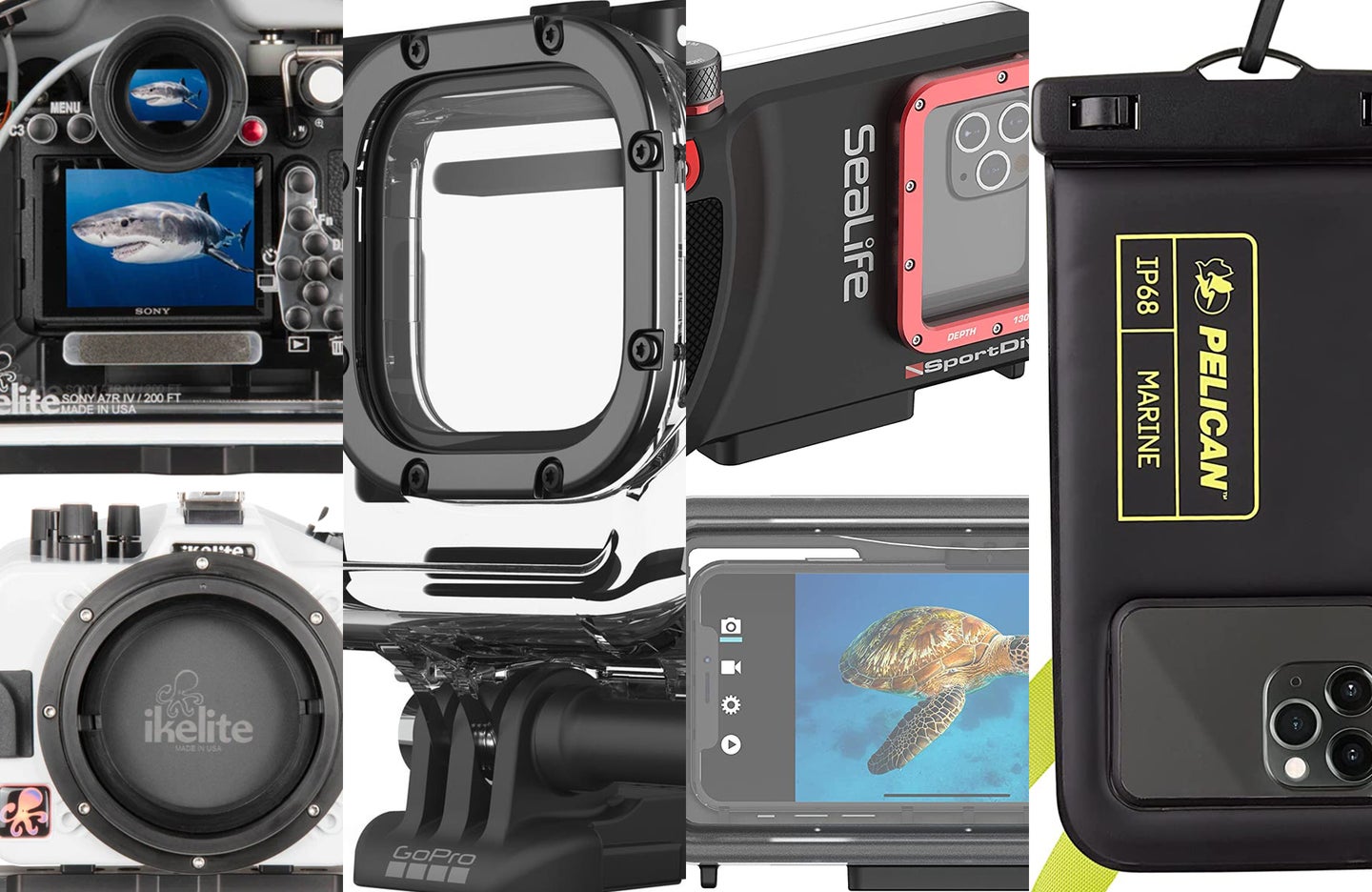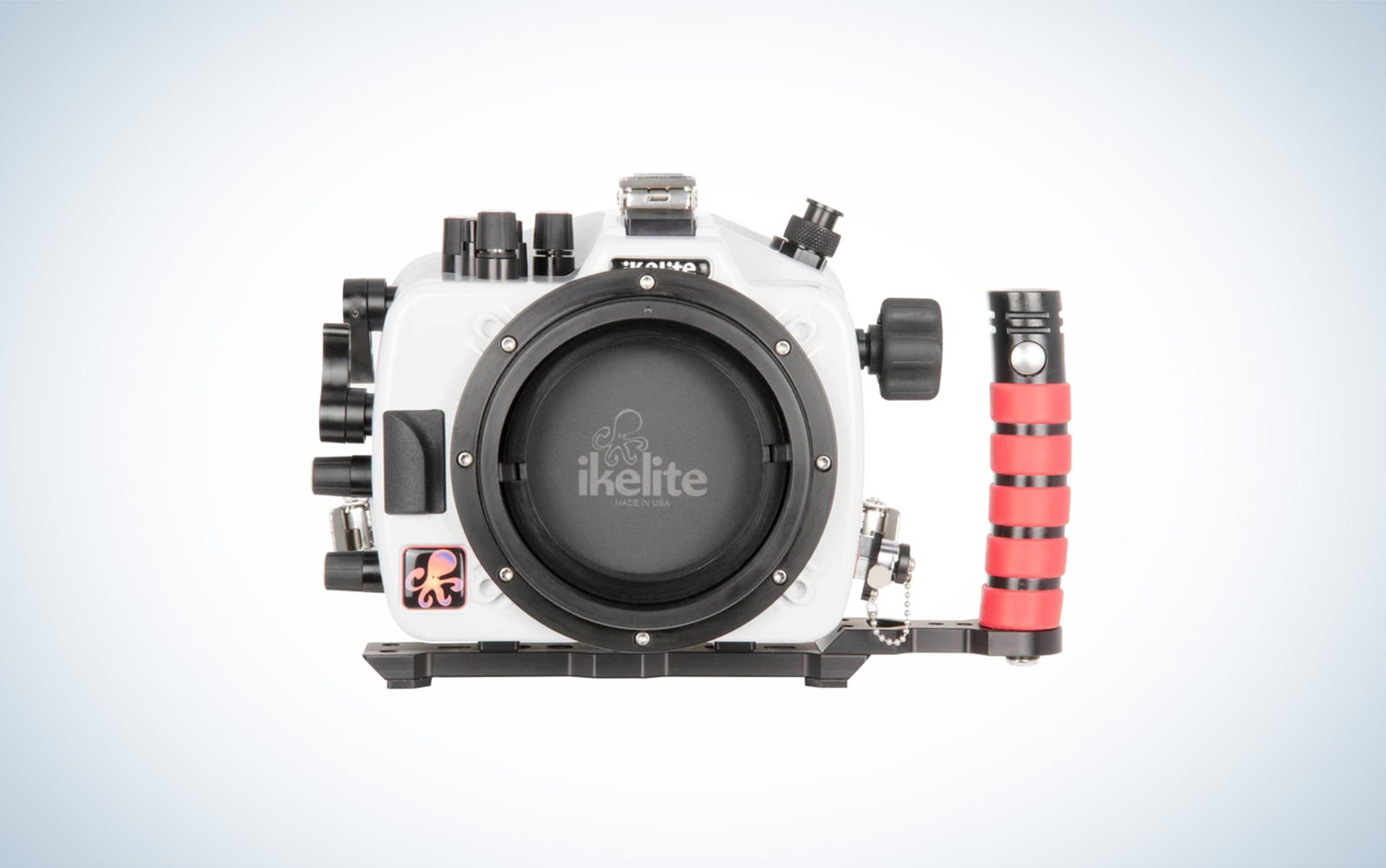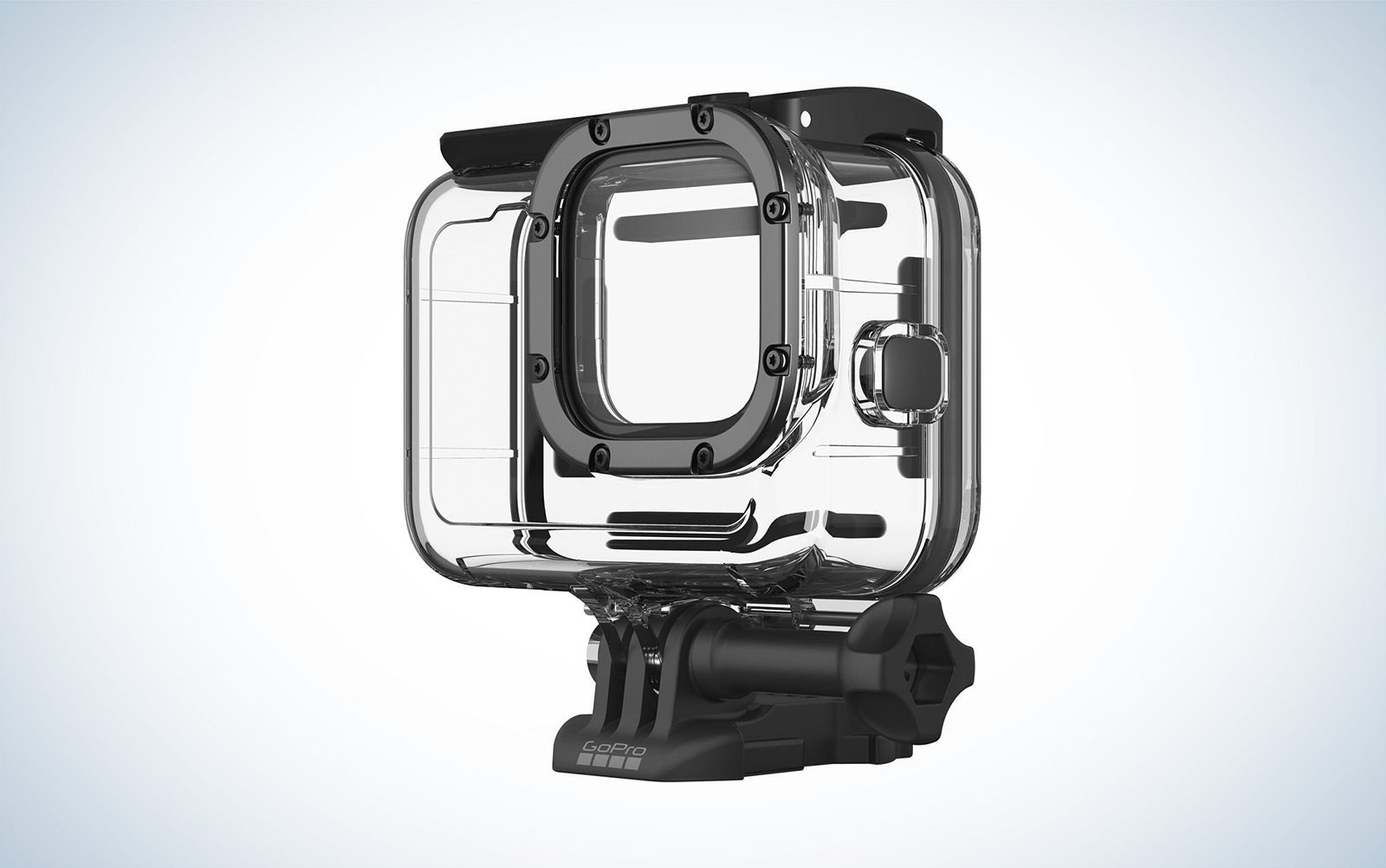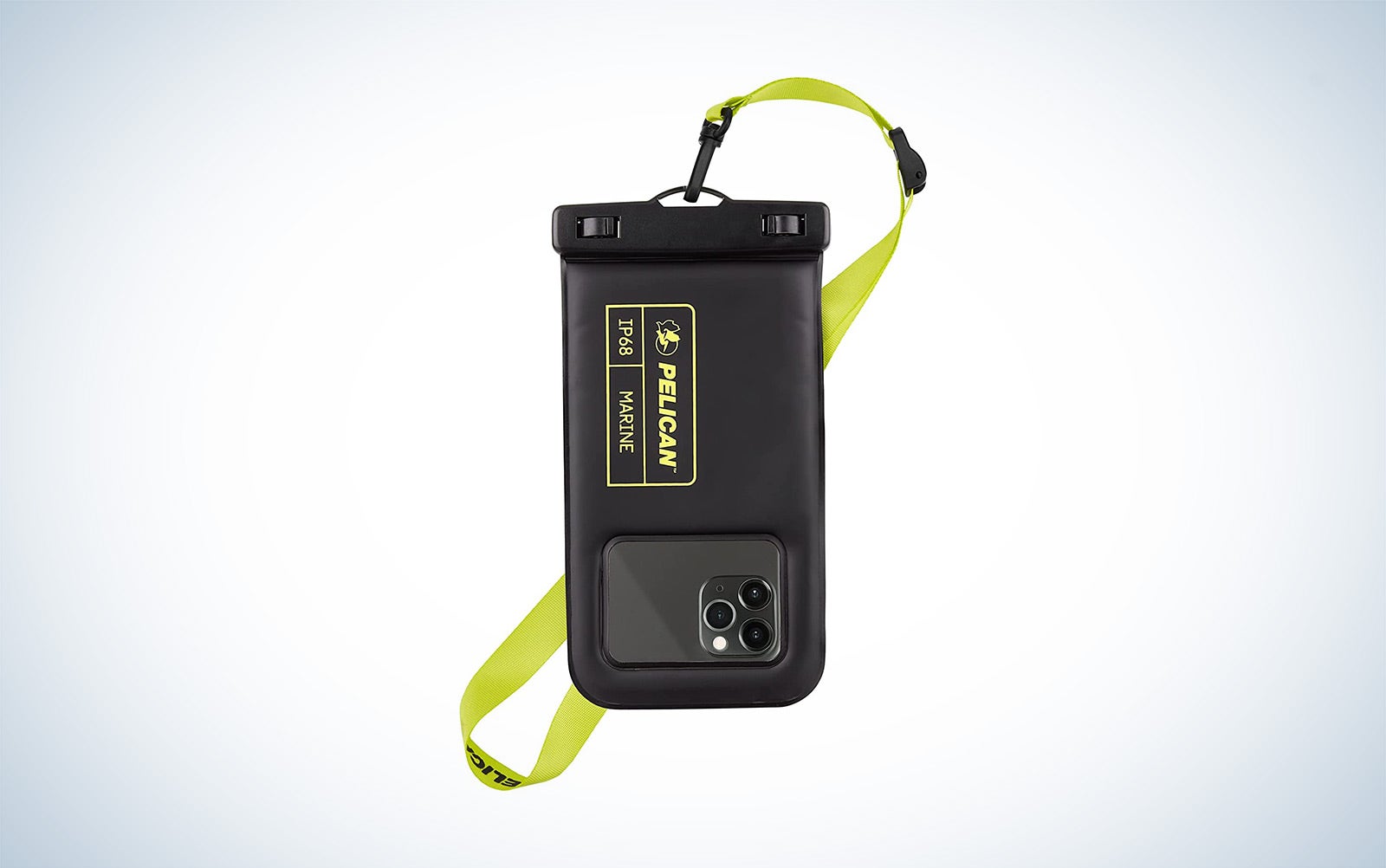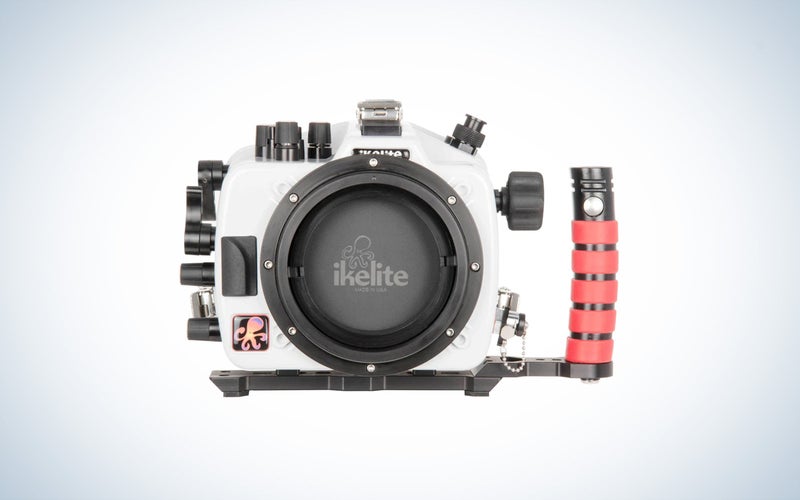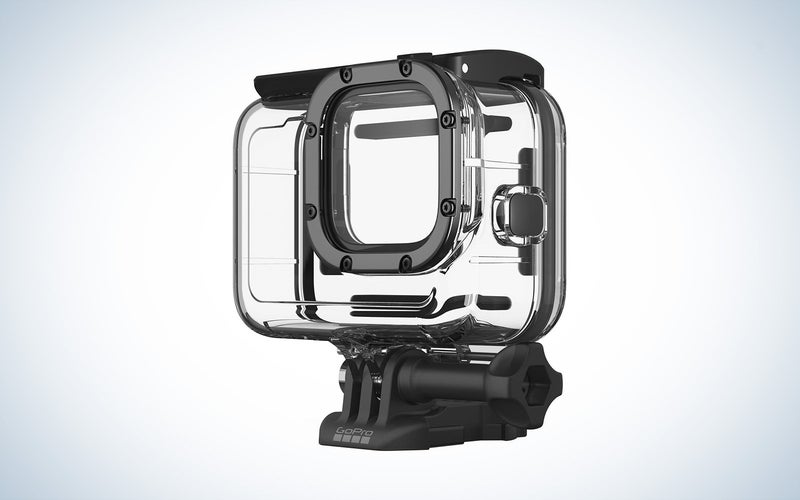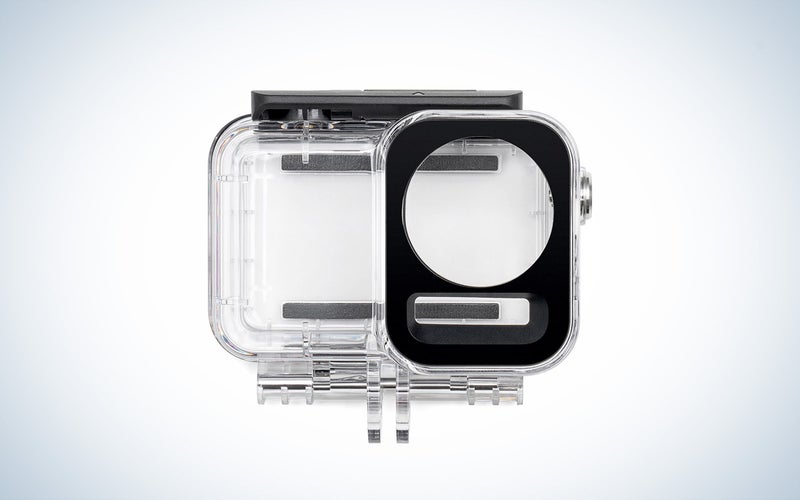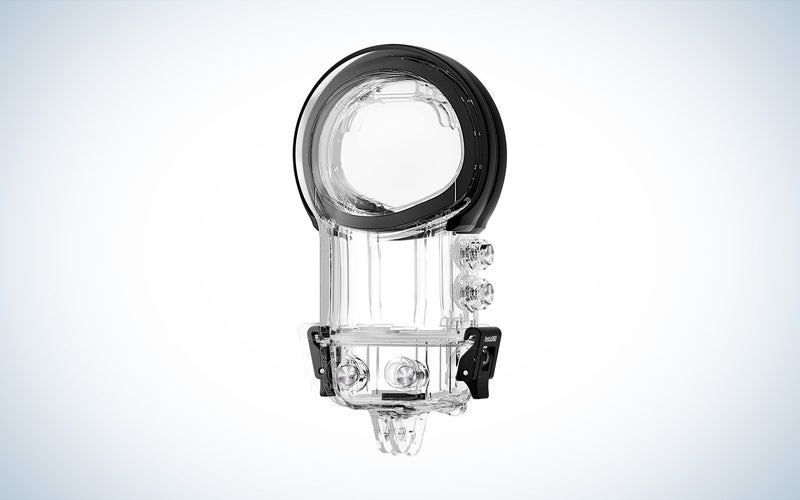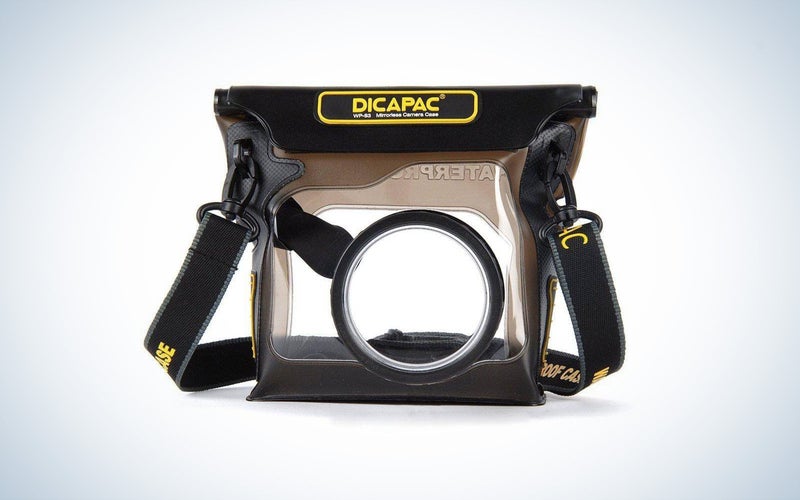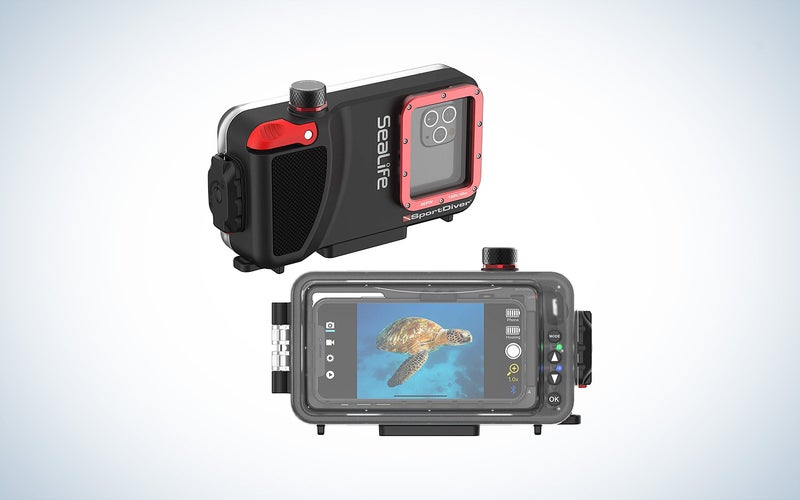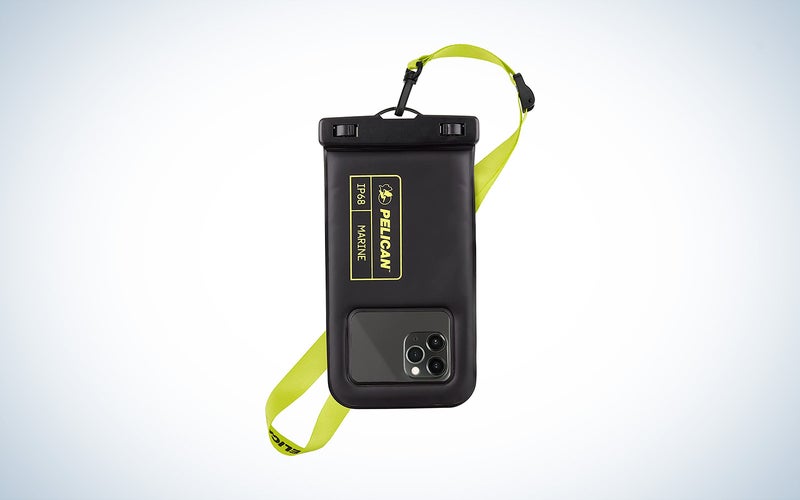We may earn revenue from the products available on this page and participate in affiliate programs. Learn more ›
Waterproof camera cases can take many forms. Whether it be a simple bag-style case for your phone or a rugged, waterproof housing for your mirrorless camera, a waterproof case can allow you to bring your camera places you couldn’t otherwise. Even if you aren’t an underwater photographer, bringing your expensive camera gear along on your rugged outdoor adventures is daunting. A camera case can not only keep water out, but it can protect against bumps and bruises.
Although most modern cameras have some level of weather sealing, they definitely aren’t meant to be submerged in water or soaked in a downpour. If you are interested in underwater photography, watertight housing is a must. Even if you simply want to have your camera along at the beach, having a case to keep it protected from the elements is a good idea. No matter what your preferred adventure type, the best waterproof camera cases will keep your camera safe and dry.
- Best for mirrorless cameras: Ikelite 200DL Underwater Housing
- Best for GoPro Hero 9, 10, or 11: GoPro Protective Housing
- Best for DJI Osmo Action 3: DJI Waterproof Case
- Best for Insta360: Insta360 X3 Dive Case
- Best budget: DiCAPac WP-S3 Waterproof Case
- Best for smartphones: SeaLife Underwater Smartphone Scuba Case
- Best budget case for smartphones: Pelican Marine – IP68 Waterproof Phone Pouch
How we picked the best waterproof camera cases
There are many different styles of waterproof camera cases—from soft bags to hard cases—, and as such, we tried to include each type in order to fit the needs of different photographers. Depth rating was a primary consideration, as it is a good indicator of how waterproof a case actually is. We also looked at what camera controls would be accessible once in the case and how easy the case would be to hold and maneuver, even underwater. Lastly, we sorted through editorial and customer reviews, especially paying attention to reports of case failures.
The best waterproof camera case: Reviews & recommendations
Best for mirrorless cameras: Ikelite 200DL Underwater Housing for Sony a7R IV
IkeLite
Specs
- Depth rating: 200 feet
- Dimensions: 9.0 x 7.3 x 6.0 inches
- Weight: 4.7 pounds
Pros
- Allows for full use of camera controls
- Waterproof to 200 feet
- Compatible with strobes
- Utilizes a range of lens ports
Cons
- Must buy a separate lens port
If you want to take your expensive mirrorless camera underwater, you’ll need some serious protection. Ikelite is one of the top choices for waterproof camera cases, making rugged housing capable of withstanding even intense surf. This particular case is even waterproof down to 200 feet. You’ll be able to trust it in just about any situation, from epic shorebreak surfing to scuba diving.
Ikelite put a ton of thought into the design of this waterproof camera case, with lots of thoughtful features for easier use when underwater. For example, it includes a handle with a shutter button for better grip. It also provides plenty of mechanical push buttons, dials, and levers for full camera control, including back button focus. The case can even be broken down to make it easier to travel with.
The case linked above is compatible with the Sony a7R IV, but Ikelite makes a range of cases compatible with many other cameras, such as the Canon EOS R5 and one for the Nikon Z7. Just be sure to pay close attention and get the correct one for your camera. Unfortunately, these waterproof housing cases don’t come with a lens port, and you will need one to use the case. That will give you more flexibility in choosing a lens, however. And luckily, Ikelite provides lots of information on finding a compatible lens port to ensure you get the right one for your case and lens.
Best for GoPro Hero 9, 10, or 11: GoPro Protective Housing
GoPro
Specs
- Depth rating: 196 feet
- Dimensions: 3.25 x 1.6 x 3 inches
- Weight: 6.4 ounces
Pros
- Doesn’t add much bulk
- Includes mounting plate
- Also protects against scratches
- Front LCD screen is still visible
Cons
- Touchscreen can’t be used with the case on
GoPros are one of the most recognizable action cam brands in the market. The last few generations of GoPros have been waterproof without housing. But if you are planning to dive deeper than 33 feet, you will need a waterproof case for it. This case works with Hero9, 10, and 11 and provides protection as deep as 196 feet of water.
The GoPro official Protective Housing includes a Skeleton Backdoor for touchscreen accessibility and audio capture. You won’t be able to use the touchscreen with that backdoor closed, however, so keep that in mind while diving. It also features a flat glass lens for better image quality when underwater.
Beyond making your GoPro even more waterproof, it also protects against mud, debris, and potential scratches. And you can still use all the typical GoPro accessories and mounts thanks to the mounting hardware built into the case. It’s a sure way to keep your GoPro safe no matter what type of activities you like to record.
Best for DJI Osmo Action 3: DJI Waterproof Case
DJI
Specs
- Depth rating: 196 feet
- Dimensions: 3.44 x 1.68 x 3.1 inches
- Weight: 3.53 ounces
Pros
- Doesn’t add much to the camera
- Waterproof down to 196 feet
- High-strength glass results in clearer photos
- Includes three anti-fog inserts
Cons
- A bit pricey for what it is
This waterproof housing for the DJI Osmo Action 3 camera is made for surfing, diving, and snorkeling. The Osmo Action 3 is waterproof to 52.5 feet without a case, but with this housing, you can take it down to 148 feet underwater. It also just adds protection all around, even when you are on dry land.
The case features high-strength glass over the lens for better clarity when taking photos and videos. It comes with three anti-fog inserts to prevent fogging when you are underwater. And it offers the standard 2-prong mount on the bottom of the case so that you can attach it to standard accessories.
Best for Insta360: Insta360 X3 Dive Case
Insta360
Specs
- Depth rating: 164 feet
- Dimensions: 6.06 x 2.64 x 3.3 inches
- Weight: 4.6 ounces
Pros
- Doesn’t add much to the camera
- Offers IPX8 water resistance
- Allows for 360-degree video underwater
Cons
- Case may obscure the very bottom of the frame
- Has the tendency to fog
The Insta360 X3 is a unique action camera that allows you to capture 360-degree photos and videos. It’s waterproof on its own down to 33 feet, but if you are diving deeper than that, you’ll need a case. The Insta360 X3 Dive case is made specifically for the X3 camera, so you can trust that it will fit just right. It may obscure the very bottom of the frame, but that’s easy to edit out in the Insta360 app.
This waterproof action camera case will allow you to go as deep as 164 feet, meaning you can even take it scuba diving with you. And it still allows for 360-degree footage, meaning you can get some truly epic photos and videos deep below the surface. It comes with six anti-fog inserts to help manage fogging and a carrying pouch to keep it from getting scratched when traveling. And the bottom of the case features a mount adapter, so you can attach a handle, making it easier to hold when swimming around.
Best budget: DiCAPac WP-S3 Waterproof Case
DiCAPac
Specs
- Depth rating: 16 feet
- Dimensions: 9.8 x 5.8 x 7.4 inches
- Weight: 12.3 ounces
Pros
- Affordable
- Easy to use
- Includes an adjustable strap
- Fits compact interchangeable lens cameras
Cons
- Difficult to use the camera in the pouch
The DiCAPac WP-S3 is essentially an advanced zip-lock bag in the shape of a camera. It’s designed to work with interchangeable lens cameras, so you can utilize different lenses as long as they fit in the lens port. There is a finger access point on the case (essentially a sleeve for your finger) that allows you to change your settings or zoom the lens while the camera is in the bag.
This bag-style case is fully waterproof down to 16 feet. That’s plenty deep for most snorkelers, allowing you to dive down to see more than you would from the surface. It will also protect your camera from any sort of debris, such as sand or mud. And it’s a lightweight bag and won’t take up much space in your bag when you travel.
Some have reported that it is tricky to get the lens into the port and to manually focus with the lens underwater. But with some fiddling, this case will enable you to use your mirrorless camera underwater or in wet conditions at a much more approachable price than other waterproof camera cases.
Best for smartphones: SeaLife Underwater Smartphone Scuba Case
SeaLife
Specs
- Depth rating: 130 feet
- Dimensions: 8.4 x 4.9 x 2.2 inches
- Weight: 1.5 pounds
Pros
- Built-in anti-fog capsule
- Large and easy-to-use controls
- Compatible with most phones
- Two leak alarms
Cons
- Expensive
For those wanting to get quality photos with their phone while scuba diving, snorkeling, or swimming, this underwater smartphone case is one of the best available. It’s a serious case—and an expensive one—but it will allow you to get the most out of your phone’s camera when underwater, unlike cheaper options.
The case features buttons on the back and an oversized shutter lever for easier use and full control of your camera underwater. You’ll be able to use the free SportDiver app, which enables you to change a long list of settings while diving. That includes switching between photo and video, shooting raw files, changing the lens in use, and manually adjusting exposure, white balance, and more.
The SeaLife case uses an anti-fog capsule to keep your camera clear for the best possible images. And it comes with a removable underwater color-correction filter to cut through all the blue for better contrast and white balance. Beyond the camera, the case provides two leak alarms—an internal moisture sensor and an internal vacuum pressure alarm—so you can have more confidence diving in with your phone. It’s compatible with iPhone 7 and up and Samsung Galaxy S9 and up, as well as most other Android phones, so you won’t need to spend time figuring out which specific case to get for your phone.
Best budget case for smartphones: Pelican Marine – IP68 Waterproof Phone Pouch
Pelican Marine
Specs
- Depth rating: 3.3 feet
- Dimensions: 4.5 x 8.98 x 0.17 inches
- Weight: 2.48 ounces
Pros
- Very affordable
- Compatible with most phones
- Floats in case you drop it
- Clear window
Cons
- Only rated to 3.3 feet
- Underwater phone use is difficult
Pouch-style waterproof camera cases, such as this Pelican Marine case, are fantastic options for more casual use. It is only rated to 3.3 feet, so you won’t be able to go on deep dives with it, but for general protection or surface snorkeling, it is excellent.
This pouch features built-in air cushions that make it buoyant. If you drop your phone over the side of a boat or let go while snorkeling, you’ll be able to easily retrieve it instead of watching it slowly sink into the depths. The neon yellow removable lanyard also makes it easier to spot. This particular pouch fits phones up to 6 inches in diameter, but you can also get the XL version if you have a larger phone.
The Pelican Marine phone pouch provides a clear window on one side for your phone’s cameras and a clear window over the touchscreen. It is challenging—and sometimes impossible—to use the touchscreen with phone pouches when underwater. But it will keep you from needing to take your phone out if you need to use it while out and about. And you can still take photos with the case on, which is an added bonus.
Things to consider when shopping for the best waterproof camera case
While most waterproof camera cases are fairly simple products, there are some essential things to consider that will significantly impact how the case functions for you. As with any purchase, honing in on why you want a waterproof case and how you will use it will guide you in making the best selection for your needs.
Camera type & brand
The first step in choosing a waterproof case for your camera is deciding what camera you will be using. Many—though not all—are designed specifically for certain devices or at least camera types. There are cases specifically built for iPhones, GoPros, or any variety of mirrorless and DSLR cameras as well.
At best, your camera won’t fit inside. But you may also lose out on some functions. Or you could potentially run into issues with waterproofing if you use a case not built for your camera. Identifying the specific camera you want to use in wet environments will allow you to get the case best suited for that.
Case type
Once you know what camera to get a case for, you can narrow down the type of case you want. Waterproof camera cases come in a few different forms. First, there are robust underwater or dive housing options that are camera-specific and fit your camera snuggly. Many allow you to choose lens ports specific to certain lenses as well, so you can truly customize your setup and get professional-level images. These are designed to give you full control of your camera even when underwater. But these are typically as—or even more— expensive as your camera itself.
A more affordable option is a bag-style case. These aren’t rigid like underwater housing, which can make them easier to pack on trips. And they usually can be used with multiple camera types as opposed to one specific camera. The downside is that they make using your camera much more challenging and sometimes flat-out impossible. They can also be flimsy and are at risk of holes, so may not be the safest option. But they are great in a pinch or for those who don’t want to spend an arm and a leg.
Depth rating
Not all waterproof camera cases are created equal. There’s a significant difference between some rain hitting your camera or case and taking the setup hundreds of feet underwater. Because of this, each manufacturer will specify the waterproof or depth rating of its cases. For example, the IkeLite case included in this list is rated to 200 feet, while the DiCAPac bag is only meant to go as deep as 16 feet.
If you know you want to dive with your camera, be sure to get a watertight housing that is rated for somewhat deeper than you plan on going. On the other hand, if you just want a waterproof case to keep your camera dry while hiking through a rainforest or hanging around waterfalls, you won’t need to worry about depth ratings.
FAQs
Q: How can I protect my camera from water?
Most modern cameras offer some level of weather resistance to prevent your gear from malfunctioning if you get stuck in a rainstorm. However, if you are planning to shoot with your camera underwater or in conditions where it might end up doused in water, it’s smart to have a waterproof case for it. Dive-proof cases offer the most protection against water.
Q: What is the best waterproof camera?
There are a number of action cams and compact point-and-shoots that offer advanced weatherproofing from the elements. The Olympus Tough line offers some of the best waterproof point-and-shoots, has a number of underwater shooting modes built-in, and are waterproof up to 50 feet without the need for additional housing. With underwater housing, the Tough cam can be used in depths of up to 147 feet.
All of the recent GoPro cameras are also waterproof without housing down to 33 feet. With housing, it can go to 196 feet. GoPros are capable of extremely high-quality video and photos, making them the top choice for professional-level content.
Q: What are the best waterproof camera cases?
The best waterproof camera case will depend on the kind of camera you have. IkeLite is an excellent option if you are planning to take your camera deep underwater, and carries a variety of makes and models for specific camera equipment. If you are shooting with an action cam, it’s best to stick with the underwater cases that are designed by the manufacturer of those cameras.
Final thoughts on the best waterproof camera case
- Best for mirrorless cameras: Ikelite 200DL Underwater Housing
- Best for GoPro Hero 9, 10, or 11: GoPro Protective Housing
- Best for DJI Osmo Action 3: DJI Waterproof Case
- Best for Insta360: Insta360 X3 Dive Case
- Best budget: DiCAPac WP-S3 Waterproof Case
- Best for smartphones: SeaLife Underwater Smartphone Scuba Case
- Best budget case for smartphones: Pelican Marine – IP68 Waterproof Phone Pouch
Capturing your adventures at the beach, lakefront, and river banks shouldn’t stress you out. The best waterproof camera case will help keep your gear safe from the elements so you can focus on capturing all the action of the day.
Why trust us
PopPhoto has a long history of delivering the opinions of some of the sharpest and most prolific camera dorks the world has to offer. Since 1937, we’ve been reviewing cameras, providing wisdom from well-known photographers, and generally just nerding out about all that goes into making great pictures. Our current crop of writers and editors have decades of professional photography and camera writing experience among them. Collectively, we’ve probably shot with just about every camera and lens combo you can imagine—as well as some obscure stuff you may not even know about. Remember the Casio Tryx folding camera? PopPhoto does.
We also get that buying a camera is a big decision, which is why we’re dedicated to helping folks choose the right one (or, in our case “ones”) for their needs. Case in point: Handing over top dollar for an expensive rig may leave you unsatisfied if it doesn’t fit your preferred shooting style. Sure, a $6,000 sports-oriented DSLR can capture landscapes, but do you really need to do it at 30 frames-per-second? No, you don’t.
